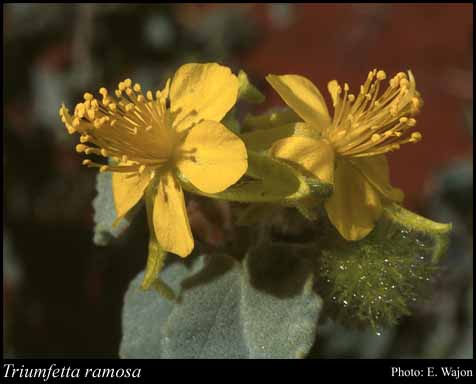- Reference
- Bull.Misc.Inform.Kew 257 (1909)
- Conservation Code
- Not threatened
- Naturalised Status
- Native to Western Australia
- Name Status
- Current
Sparingly branched shrub, 0.3-1.3 m high. Fl. yellow, Apr to Aug. Red sand, sandy & stony skeletal soils. Sandplains, dunes, rocky creek beds, ridges.

Scientific Description
Shrub, with hairy stems. Leaves 15-35 mm long, 8-20 mm wide, not lobed; margins sinuate; hairy, with stellate hairswith scales absent, Sessile glands absent; stipules present but early deciduous (only visible on youngest leaves). Perianth clearly of two whorls (calyx and corolla), the corolla obvious and prominent. Pedicel present, 3.2-8.5 mm long; indumentum present, with scales absent. Epicalyx (extra segments or 'bracteoles' immediately below the calyx) absent. Calyx 9-12 mm long, the lobes fused less than half their length, Sessile glands absent, simple hairs (without tubercle bases) absent, stellate hairs present, tubercle-based simple hairs absent, gland-tipped hairs absent, scales absent, Terminal appendages present, number of ribs absent. Corolla yellow, 7.6-9.5 mm long, glabrous. Indumentum (outside) Sessile glands absent. Stamens many, free and inserted at the base of the ovary; filaments present, 5.6-6 mm long; anthers 0.6-0.9 mm long, indumentum absent (anthers glabrous). Staminodes absent, appendages absent. Ovary hairs or scales present, simple hairs absent, stellate hairs present, gland-tipped hairs absent; style 1, with a lobed or capitate stigma, 7-10 mm long, with one style branches or lobes, mostly glabrous, wing absent. Fruits dehiscent (capsules and follicles) or indehiscent and not splitting into sections (drupes), length-width ratio more or less as long as wide, hairs or scales present, simple hairs (without tubercle bases) absent, stellate hairs present, Sessile glands absent, tubercle-based simple hairs absent, gland-tipped hairs absent; apex rounded; prickles present, abundantly covering the fruit or absent (except perhaps a terminal awn); terminal awns or spines absent; calyx deciduous before maturity, not accrescent. Flowering time April, May, June, July or August. Distribution Botanical Province Northern, IBRA Bioregion Pilbara, Carnarvon, Gascoyne and Dampierland.
Distribution
- IBRA Regions
- Carnarvon, Dampierland, Gascoyne, Pilbara.
- IBRA Subregions
- Ashburton, Cape Range, Chichester, Hamersley, Pindanland, Roebourne, Wooramel.
- Local Government Areas (LGAs)
- Ashburton, Carnarvon, East Pilbara, Exmouth, Karratha, Port Hedland.